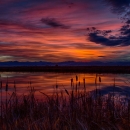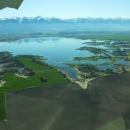About Us
The gently rolling terrain of Benton Lake National Wildlife Refuge is dominated by native mixed-grass prairie and surrounded by mountain ranges on three sides: the Highwood Mountains to the east, the Big Belt Mountains to the south, and the Rocky Mountains to the west. The Refuge is located at the western edge of the famed Prairie Pothole Region (PPR), an area characterized by millions of wetlands or "potholes" which serve as the breeding ground for most of the Nation's waterfowl. These wetlands also harbor scores of other wetland-dependent wildlife, including many endangered species. The PPR is characterized by boom and bust cycles tied to precipitation and runoff.
Wetlands
The Refuge includes over 6,000 acres of wetland habitat. The once seasonally flooded wetland basin was transformed to a semi-permanent wetland basin in the early 1960's and is now returning to a seasonal basin with a variety of wetland flooding and drying regimes.
When the Refuge was established in 1929, the flooding of the wetland basin fluctuated with the amount of natural runoff received. This included large shifts in the duration and depth of flooding in the wetland basin from several hundred acres to over 6,000 acres. These shifts corresponded to the wet and dry cycle of the Northern Great Plains prairies.
Concern with the fluctuations in flooding and extended dry periods prompted members of the Cascade County Wildlife Association to secure Congressional funding to transform the marsh into a consistently wet environment. From 1958-1962, a pump station, pipeline, and multiple impoundments with water-control structures were constructed to bring irrigation return flow water from Muddy Creek about 15 miles west of the Refuge. This management regime was implemented with some modifications until 2012.
The consistent flooding regime resulted in unexpected consequences including: selenium toxicity, domination of single vegetative species, establishment and aggressive expansion of non-native vegetative species, and loss of production. The Service in cooperation with local interest groups and Montana Fish, Wildlife, and Parks recently developed an alternative management plan that will restore the wetland health and strive to provide reliable fall waterfowl hunting opportunity. More information about this management direction can be found in the Final Comprehensive Conservation Management Plan for the Benton Lake National Wildlife Refuge Complex.
Prairie
The Refuge includes nearly 6,000 acres of intact, northern mixed-grass prairie.
Since sixty to ninety percent of the original native grasslands have been lost in the Prairie Pothole Region of Montana, preservation of native prairie is extremely important. Visitors to the Refuge can experience the vastness of the "big sky" and relatively undisturbed prairie landscapes. Native prairie areas are important to grassland-dependent species such as northern pintail, burrowing owl, chestnut-collared longspur, and Sprague's pipit as well as other species of concern. These wildlife species favor large expanses of native prairie and are negatively impacted by its development and conservation to agricultural uses. Large, intact native prairie communities can still be found throughout the Refuge Complex.
Our Mission
Refuge conservation plans are called “comprehensive conservation plans”.
The purpose of a comprehensive conservation plan is to specify a management direction for the Refuge for the next 15 years. The goals, objectives, and strategies for improving Refuge conditions—including the types of habitat we will provide, partnership opportunities, and management actions needed to achieve desired conditions – are described in the recently updated comprehensive conservation plan. The Service’s management direction for the Refuge and its effects on the human environment, are described in the comprehensive conservation plan as well.
The CCP identified the following vision for the Benton Lake National Wildlife Refuge Complex:
The spirit of the American West Resonates on both sides of the Continental Divide in the prairies, mountains, rivers, and wetlands of the Benton Lake National Wildlife Refuge Complex. Here, migratory birds fill the sky, bull trout thrive, and grizzlies and wolves still roam. Visitors experience many of the same landscapes that Lewis and Clark explored on their journey through the “Crown of the Continent.” Conservation efforts in the refuge complex protect intact landscapes, manage productive habitats, and offer people opportunities to connect with wildlife in solitude under Montana’s big sky. These efforts rely on innovative public and private partnerships, are supported by the region’s people, and harmonize with the historic rural economy.
Our History
During Montana's early development, Benton Lake was first viewed as a resource to be exploited. In 1885, the government excluded the Benton Lake basin from homesteading so it could be used as a reservoir for irrigating lands to the east. That plan proved to be impractical. Early in the 20th century, several Montana businessmen planned to "reclaim" the wetlands for use as croplands. A ditch 26 feet deep and 1 1/2 miles long was dug, but the drainage was ineffective and the project was abandoned. This early drainage ditch is still visible from the blacktop road leading to the Refuge.
As surrounding land was settled, local sportsmen pushed for the establishment of a refuge to keep the area in public ownership. By Executive Order of President Herbert Hoover in 1929, Benton Lake was set aside as a "refuge and breeding ground for birds."
Other Facilities in this Complex
Western Montana National Wildlife Refuge Complex
For the Western Montana National Wildlife Refuge Complex, the project leader is stationed at Benton Lake National Wildlife Refuge and oversees general management of the Complex. Refuge managers oversee the operations at specific refuges. Supporting staff, composed of administrative, law enforcement, refuge manager, biological, fire, visitor services, and maintenance professionals support all refuges within the complex.
The Complex headquarters is located at Benton Lake National Wildlife Refuge, 922 Bootlegger Trail, Great Falls MT 59404.
The Bison Range is proudly managed by the Confederated Salish and Kootenai Tribes of the Flathead Reservation.
The National Bison Range was established on May 23, 1908, when President Theodore Roosevelt signed legislation authorizing funds to purchase land for bison conservation. It was the first time Congress appropriated tax dollars to buy land specifically to preserve wildlife. The Consolidated Appropriations Act, 2021 (Public Law 116-260), approved the transfer by repealing the statute that created the National Bison Range. The Act included a two-year period for transitioning the Range’s management from the U.S. Fish and Wildlife Service to the Tribes. With that process complete, the Confederated Salish and Kootenai Tribes assumed full management of the Bison Range on January 2, 2022.
Bison Range Website: https://bisonrange.org/
Bison Range on Facebook: https://www.facebook.com/CSKTBisonRange
Interior Transfers National Bison Range Lands in Trust for the Confederated Salish and Kootenai Tribes:
https://www.doi.gov/pressreleases/interior-transfers-national-bison-ran…)
The refuges in the Western Montana National Wildlife Refuge Complex include:

